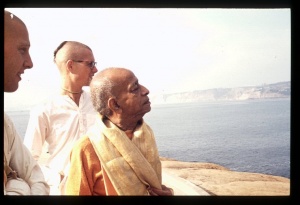CC Madhya 19.102 (1975): Difference between revisions
(Vanibot #0027: CCMirror - Mirror CC's 1996 edition to form a basis for 1975) |
(Vanibot #0020: VersionCompareLinker - added a link to the Version Compare feature) |
||
| Line 2: | Line 2: | ||
<div style="float:left">'''[[Sri Caitanya-caritamrta (1975)|Śrī Caitanya-caritāmṛta (1975)]] - [[CC Madhya (1975)|Madhya-līlā]] - [[CC Madhya 19 (1975)|Chapter 19: Lord Śrī Caitanya Mahāprabhu Instructs Śrīla Rūpa Gosvāmī]]'''</div> | <div style="float:left">'''[[Sri Caitanya-caritamrta (1975)|Śrī Caitanya-caritāmṛta (1975)]] - [[CC Madhya (1975)|Madhya-līlā]] - [[CC Madhya 19 (1975)|Chapter 19: Lord Śrī Caitanya Mahāprabhu Instructs Śrīla Rūpa Gosvāmī]]'''</div> | ||
<div style="float:right">[[File:Go-previous.png|link=CC Madhya 19.101 (1975)|Madhya-līlā 19.101]] '''[[CC Madhya 19.101 (1975)|Madhya-līlā 19.101]] - [[CC Madhya 19.103 (1975)|Madhya-līlā 19.103]]''' [[File:Go-next.png|link=CC Madhya 19.103 (1975)|Madhya-līlā 19.103]]</div> | <div style="float:right">[[File:Go-previous.png|link=CC Madhya 19.101 (1975)|Madhya-līlā 19.101]] '''[[CC Madhya 19.101 (1975)|Madhya-līlā 19.101]] - [[CC Madhya 19.103 (1975)|Madhya-līlā 19.103]]''' [[File:Go-next.png|link=CC Madhya 19.103 (1975)|Madhya-līlā 19.103]]</div> | ||
{{CompareVersions|CC|Madhya 19.102|CC 1975|CC 1996}} | |||
{{RandomImage}} | {{RandomImage}} | ||
==== TEXT 102 ==== | ==== TEXT 102 ==== | ||
<div class="verse"> | <div class="verse"> | ||
:śyāma-rūpera vāsa-sthāna śreṣṭha | :śyāma-rūpera vāsa-sthāna śreṣṭha māna' kāya? | ||
: | :'purī madhu-purī varā'--kahe upādhyāya | ||
</div> | </div> | ||
| Line 18: | Line 17: | ||
<div class="synonyms"> | <div class="synonyms"> | ||
śyāma-rūpera—of the supreme form, Śyāmasundara; vāsa-sthāna—residence; śreṣṭha—the supreme; | śyāma-rūpera—of the supreme form, Śyāmasundara; vāsa-sthāna—residence; śreṣṭha—the supreme; māna'-you accept; kāya—which; purī—the city; madhu-purī—Mathurā; varā—best; kahe—said; upādhyāya—Raghupati Upādhyāya. | ||
</div> | </div> | ||
| Line 25: | Line 24: | ||
<div class="translation"> | <div class="translation"> | ||
"Of all Kṛṣṇa's abodes, which do you think is the best?" Raghupati Upādhyāya said,"Madhu-purī, or Mathurā-dhāma, is certainly the best." | |||
Raghupati Upādhyāya said, | |||
</div> | </div> | ||
| Line 33: | Line 31: | ||
<div class="purport"> | <div class="purport"> | ||
Lord Kṛṣṇa has many forms, as stated in the Brahma-saṁhitā ( | Lord Kṛṣṇa has many forms, as stated in the Brahma-saṁhitā (5.33): advaitam acyutam anādim ananta-rūpam. Śrī Caitanya Mahāprabhu asked Raghupati Upādhyāya which form was the best of Lord Kṛṣṇa's millions of forms, and he immediately replied that the supreme form was the Śyāmasundara form. In that form, Kṛṣṇa stands curved in three places and holds His flute. The Śyāmasundara form is also described in the Brahma-saṁhitā (5.38): | ||
premāñjana-cchurita-bhakti-vilocanena | |||
:santaḥ sadaiva hṛdayeṣu vilokayanti | :santaḥ sadaiva hṛdayeṣu vilokayanti | ||
:yaṁ śyāmasundaram acintya-guṇa-svarūpaṁ | :yaṁ śyāmasundaram acintya-guṇa-svarūpaṁ | ||
:govindam ādi-puruṣaṁ tam ahaṁ bhajāmi | :govindam ādi-puruṣaṁ tam ahaṁ bhajāmi | ||
"I worship the primeval Lord, Govinda, who is always seen by the devotee whose eyes are anointed with the pulp of love. He is seen in His eternal form of Śyāmasundara situated within the heart of the devotee." | |||
Those who are filled with ecstatic love for Kṛṣṇa always see the form of Śyāmasundara within their hearts. Raghupati Upādhyāya confirms that the Absolute Truth, the Supreme Personality of Godhead, has many | |||
Those who are filled with ecstatic love for Kṛṣṇa always see the form of Śyāmasundara within their hearts. Raghupati Upādhyāya confirms that the Absolute Truth, the Supreme Personality of Godhead, has many incarnations-Nārāyaṇa, Nṛsiṁha, Varāha and others-but Kṛṣṇa is distinguished as the supermost. According to Śrīmad-Bhāgavatam: kṛṣṇas tu bhagavān svayam. "Kṛṣṇa is the original Personality of Godhead." Kṛṣṇa means Śyāmasundara, who plays His flute in Vṛndāvana. Of all forms, this form is the best of all. Kṛṣṇa lives sometimes in Mathurā and sometimes in Dvārakā, but Mathurā is considered the better place. This is also confirmed by Rūpa Gosvāmī in his Upadeśāmṛta (9): vaikuṇṭhāj janito varā madhu-purī. "Madhu-purī, or Mathurā, is far superior to the Vaikuṇṭhalokas in the spiritual world." | |||
</div> | </div> | ||
Latest revision as of 11:37, 27 January 2020

A.C. Bhaktivedanta Swami Prabhupada
TEXT 102
- śyāma-rūpera vāsa-sthāna śreṣṭha māna' kāya?
- 'purī madhu-purī varā'--kahe upādhyāya
SYNONYMS
śyāma-rūpera—of the supreme form, Śyāmasundara; vāsa-sthāna—residence; śreṣṭha—the supreme; māna'-you accept; kāya—which; purī—the city; madhu-purī—Mathurā; varā—best; kahe—said; upādhyāya—Raghupati Upādhyāya.
TRANSLATION
"Of all Kṛṣṇa's abodes, which do you think is the best?" Raghupati Upādhyāya said,"Madhu-purī, or Mathurā-dhāma, is certainly the best."
PURPORT
Lord Kṛṣṇa has many forms, as stated in the Brahma-saṁhitā (5.33): advaitam acyutam anādim ananta-rūpam. Śrī Caitanya Mahāprabhu asked Raghupati Upādhyāya which form was the best of Lord Kṛṣṇa's millions of forms, and he immediately replied that the supreme form was the Śyāmasundara form. In that form, Kṛṣṇa stands curved in three places and holds His flute. The Śyāmasundara form is also described in the Brahma-saṁhitā (5.38):
premāñjana-cchurita-bhakti-vilocanena
- santaḥ sadaiva hṛdayeṣu vilokayanti
- yaṁ śyāmasundaram acintya-guṇa-svarūpaṁ
- govindam ādi-puruṣaṁ tam ahaṁ bhajāmi
"I worship the primeval Lord, Govinda, who is always seen by the devotee whose eyes are anointed with the pulp of love. He is seen in His eternal form of Śyāmasundara situated within the heart of the devotee."
Those who are filled with ecstatic love for Kṛṣṇa always see the form of Śyāmasundara within their hearts. Raghupati Upādhyāya confirms that the Absolute Truth, the Supreme Personality of Godhead, has many incarnations-Nārāyaṇa, Nṛsiṁha, Varāha and others-but Kṛṣṇa is distinguished as the supermost. According to Śrīmad-Bhāgavatam: kṛṣṇas tu bhagavān svayam. "Kṛṣṇa is the original Personality of Godhead." Kṛṣṇa means Śyāmasundara, who plays His flute in Vṛndāvana. Of all forms, this form is the best of all. Kṛṣṇa lives sometimes in Mathurā and sometimes in Dvārakā, but Mathurā is considered the better place. This is also confirmed by Rūpa Gosvāmī in his Upadeśāmṛta (9): vaikuṇṭhāj janito varā madhu-purī. "Madhu-purī, or Mathurā, is far superior to the Vaikuṇṭhalokas in the spiritual world."